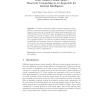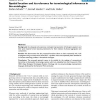1676 search results - page 140 / 336 » Formal Development of Self-organising Systems |
TAAS
2010
14 years 4 months ago
2010
stractions that support application developers to describe dynamic organizations. The organization model is part of an integrated approach, called MACODO: Middleware Architecture f...
149
click to vote
FASE
2011
Springer
14 years 1 months ago
2011
Springer
Probabilistic verification techniques have been applied to the formal modelling and analysis of a wide range of systems, from communication protocols such as Bluetooth, to nanosca...
AGI
2011
14 years 1 months ago
2011
Abstract. Recurrent connectivity, balanced between excitation and inhibition, is a general principle of cortical connectivity. We propose that balanced recurrence can be achieved b...
TPHOL
2005
IEEE
15 years 3 months ago
2005
IEEE
We describe a formalization of the elementary algebra, topology and analysis of finite-dimensional Euclidean space in the HOL Light theorem prover. (Euclidean space is RN with the...
BMCBI
2007
14 years 10 months ago
2007
Background: An adequate and expressive ontological representation of biological organisms and their parts requires formal reasoning mechanisms for their relations of physical aggr...


